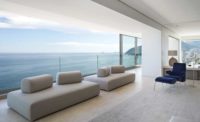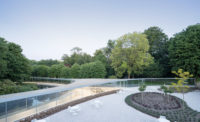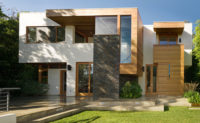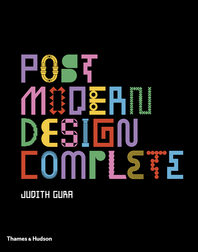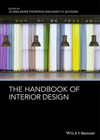Hidden Tints Apartment by Note Design Studio
Stockholm

Painted in a soft pastel based on old paint colors discovered during the renovation, a new kitchen/dining area occupies the apartment’s largest and most central room. Its terrazzo island, mustard-colored pendant light, and custom sage-green cabinet feel at home with existing architectural details.
Photo courtesy Note Design Studio

The living room features a Tabula table by the architects and a Piero Lissoni Rod sofa.
Photo courtesy Note Design Studio

The living room features one of the building’s original tiled stoves.
Photo courtesy Note Design Studio

The children’s room is outfitted with custom casework and N65 chairs by Alvar Aalto. A swing serves as a playful and artistic focal point.
Photo courtesy Note Design Studio

A new veneered wall in the master bedroom has a scored pattern inspired by the parquet oak floor.
Photo courtesy Note Design Studio

This same motif reppears on the new cabinetry in the study, as well as in the other rooms in the apartment.
Photo courtesy Note Design Studio

This same motif reppears on the new cabinetry in the study, as well as in the other rooms in the apartment.
Photo courtesy Note Design Studio

Image courtesy Note Design Studio








Architects & Firms
When Stockholm resident Johan Malmberg started looking for a new home for his family, the inflated prices of the housing market in the Swedish capital meant that he had two options: pay a great deal of money for an old apartment and then spend even more renovating it, or buy something new. “But, then,” he says, “nothing is ever exactly as you want it to be.” So when Malmberg saw a 1,900-square-foot space that had recently housed the nondescript headquarters of a fashion company, he saw its potential, despite its not having a full bathroom or kitchen. Located on the fourth floor of a 19th-century corner building, originally a private house in Östermalm, a wealthy residential district, the carpeted, all-white commercial space would provide an opportunity to build an apartment to suit his specifications. While it was filled with distinct historic details, its charms were mostly under wraps. Despite needing to be completely fit out to make it a residence, the price luckily was right.
Additional Content:
Jump to credits & specifications
Before he even found an architect, he had a rough idea of the layout he wanted—an entry hall leading to a study, small laundry, and common bathroom on the left, and a kitchen and dining area installed in the large central space to the right. That would be flanked by a living room and children’s room on one side, and a master suite on the other. In selecting the right firm for the job, Malmberg says, “I felt the project needed to be in the hands of a studio with an overarching set of skills.” He chose Note Design Studio for its ability to handle everything, from the smallest details to furniture design and overseeing construction.
The versatile Stockholm-based studio, which does architecture and interiors as well as product and graphic design, chooses to immerse itself fully in the process of creating a space for the few private commissions they accept. Though time-consuming and labor intensive, the architects see this approach as the best way to guarantee quality. It meant starting with the deconstruction of the space, as it had been altered over the years, in order to honor its history and imbue it with new life. “Respecting the previous architecture was a very important point for us,” says Cristiano Pigazzini, firm cofounder. “We see many beautiful renovations, but they often disregard the history or the value of the previous architecture.” In order to avoid this, the studio began to strip away the traces of the 20th-century office—the carpeting and dropped acoustic ceiling with its spotlights—gradually revealing the space’s full potential.
Striving to honor the distinguishing characteristics of the apartment’s original design and decoration, Note restored its ornate door frames and stucco ceilings, refurbished or replicated its patterned oak-wood floors, and incorporated its original porcelain-tiled corner stoves into their design. As they did this, they drew a line between past and present, steering clear of pastiche by designing all missing elements in a contemporary, minimalist—and very Scandinavian—style. They even differentiated two new walls by keeping them without moldings at the floor and ceiling, and then surfacing them with a scored pattern that echoes the parquet floors—a motif they would repeat on the doors of custom cabinets throughout the apartment.
As they carefully removed layers of the 20th-century office, they discovered traces of a mustard-yellow paint from the 19th century that—along with the pink, green, and yellowish-white tiles of the three stoves—inspired the design team to develop an eight-tone color palette. (It also led the architects to name the project Hidden Tints for the palimpsest aspect of the hues.) This allowed them to give each room a singular identity while contributing to a coherent atmosphere throughout the apartment. “We wanted the transition between the rooms to be smooth, with the same aesthetic characteristics everywhere,” says Susanna Wåhlin, the firm’s interior architect.
Even though Malmberg expected to use most of the furniture from his old apartment, he soon understood that “pushing the old furniture into the new apartment could destroy the potential of the place.” The only piece that survived was a long dining table, which was sanded and finished to better blend into its new home. Note further explored the underlying color and material palette. In imagining furniture pieces and lighting fixtures, they customized a variety of their own product designs to match the palette of yellow, green, and pink hues. “We never push our furniture pieces in our projects, but in this case they do fit well,” says Pigazzini. “Sometimes our work is easier, because we can customize every piece with the right color and material for a specific project by going to the manufacturers that already collaborate with us.”
Adamant that there is a sustainable advantage to a “less but better” formula, the remaining pieces chosen by the studio include iconic 20th- and 21st-century designs such as the children’s chair N65 by Alvar Aalto, a wire mesh Cloud pendant lamp by Benedetta Mori Ubaldini, and a Vertigo lamp by Constance Guisset. “We wanted each piece to be an investment in quality,” Pigazzini says.
Despite, or maybe because of, its disparate elements, nothing in the apartment seems unbalanced, excessive, or out of place. As the owner puts it, “The house’s distinct color scheme and design is relaxing and stable. It’s going to be hard to destroy it, even when we start decorating with what we bring as we live here.”
CreditsArchitect: Note Design Studio — Cristiano Pigazzini, founder; Susanna Wåhlin, My Degerth, interior architects
Client: Johan Malmberg
|
SpecificationsCase goods Lerch Träinredningar
Furniture Karl Andersson & Söner (Shell stool); Federicia (Pato swivel armchair); Gubi (Beetle lounge chair, ottoman, and sofa); Living Divani (Rod sofa); &tradition (Catch lounge chair); Won (Mango lounge chair); Magis (Clouds hanging sculpture)
Lighting Zero (Silo pendant and floor lamps); Areti (Two Spheres pendant and Row sconce); Vibia (Pin 1655); Flos (Mini Glo-Ball and Glo-Ball Basic) |

